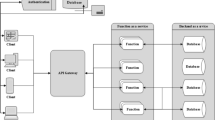Abstract
We analyze the Two Level Processor Sharing (TLPS) scheduling discipline with the hyper-exponential job size distribution and with the Poisson arrival process. TLPS is a convenient model to study the benefit of the file size based differentiation in TCP/IP networks. In the case of the hyper-exponential job size distribution with two phases, we find a closed form analytic expression for the expected sojourn time and an approximation for the optimal value of the threshold that minimizes the expected sojourn time. In the case of the hyper-exponential job size distribution with more than two phases, we derive a tight upper bound for the expected sojourn time conditioned on the job size. We show that when the variance of the job size distribution increases, the gain in system performance increases and the sensitivity to the choice of the threshold near its optimal value decreases.
Similar content being viewed by others
References
Aalto, S., & Ayesta, U. (2006). Mean delay analysis of multilevel processor sharing disciplines. In Proceedings of IEEE INFOCOM 2006.
Avrachenkov, K., et al. (2004). Differentiation between short and long TCP flows: Predictability of the response time. In Proceedings of IEEE INFOCOM 2004.
Avrachenkov, K., et al. (2005). Batch arrival processor-sharing with application to multi-level processor-sharing scheduling. Queueing Systems, 50, 459–480.
Baccelli, F., & McDonald, D. (2006). A stochastic model for the rate of non-persistent TCP flows. In Proceedings of ValueTools 2006.
Bansal, N. (2003). Analysis of the M/G/1 processor-sharing queue with bulk arrivals. Operations Research Letters, 31(5), 401–405.
Feldmann, A., & Whitt, W. (1998). Fitting mixtures of exponentials to long-tail distributions to analyze network performance models. Performance Evaluation, 31, 245–258.
Feng, H., & Misra, V. (2003). Mixed scheduling disciplines for network flows. ACM SIGMETRICS Performance Evaluation Review, 31(2), 36–39.
Guo, L., & Matta, L. (2002). Differentiated control of web traffic: A numerical analysis. In SPIE ITCOM, Boston, 2002.
Harchol-Balter, M., et al. (2003). Size-based scheduling to improve web performance. ACM Transactions on Computer Systems, 21(2), 207–233.
Khayari, R. E. A., et al. (2003). Fitting world-wide web request traces with the EM-algorithm. Performance Evaluation, 52(2–3), 175–191.
Kleinrock, L. (1976). Queueing systems (vol. 2). New York: Wiley.
Osipova, N. (2008). Batch Processor Sharing with Hyper-Exponential service time. Operations Research Letters, 36(3), 372–376.
Schrage, L. (1968). A proof of the optimality of the shortest remaining processing time discipline. Operations Research, 16, 687–690.
Author information
Authors and Affiliations
Corresponding author
Additional information
The work was supported by France Telecom R&D Grant “Modélisation et Gestion du Trafic Réseaux Internet” no. 46129414.
Rights and permissions
About this article
Cite this article
Avrachenkov, K., Brown, P. & Osipova, N. Optimal choice of threshold in Two Level Processor Sharing. Ann Oper Res 170, 21–39 (2009). https://doi.org/10.1007/s10479-008-0430-2
Published:
Issue Date:
DOI: https://doi.org/10.1007/s10479-008-0430-2




